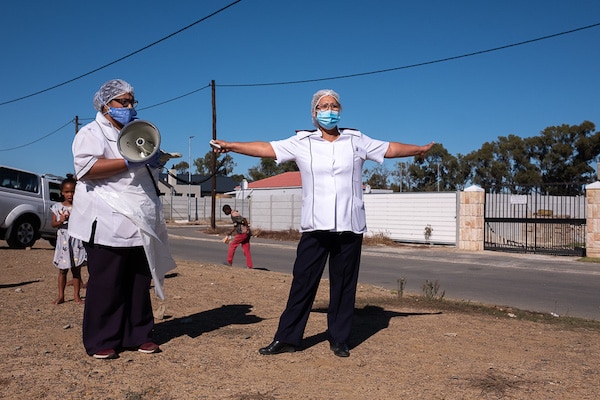In the United Nations’ Universal Declaration of Human Rights (1948), Article 25 offers an expanded vision of what it could mean to be a human being. Human beings, it notes, have ‘the right to a standard of living adequate for [their] health and well-being’. This includes ‘food, clothing, housing and medical care and necessary social services’; human beings also have the ‘right to security’, which means they have the right to compensation for any lack of livelihood due to circumstances beyond their control.
Little of this vision has come to pass for the majority of the world’s people. What workers’ movements and anti-colonial movements have been able to gain in the past hundred years has been chipped away at by a regime of austerity that cuts public funds for the right to health and well-being, that sells the right to provide these services for profit to the private sector, and that therefore cheapens human rights into commodities that remain outside the reach of those without sufficient income.
During the global pandemic, there has been much talk about ‘essential’ workers and about reforms such as shorter work hours, better working conditions, and higher wages. But—as in previous crises—all of this is likely to be forgotten once the crisis is seen to have ended. The bourgeois governments are not capable of making these reforms permanent, or of permanently rewarding the healthcare workers in a ‘normal’ situation. Ruling classes around the world punish any government that attempts this small dose of humanity because—they argue—such welfare payments create a ‘moral hazard’, and any permanent workers’ rights create a bad example to other workers.

9 May 2020: From left to right, Luyanda Mto, Dr. Celeste Jonker, and Buhle Nkomonda at the pop-up testing centre outside of the Khayelitsha District Hospital. The centre was set up to help swab more than 270 employees of three shopping centres who had close contact with other workers there who tested positive. Barry Christianson / New Frame.
In our dossier no. 29, we argue against the return to normal—specifically in the healthcare systems of the bourgeois order. In Part 1, we go over what the pandemic has shown us about the healthcare system; then, in Part 2, we attend to the voices of leaders of healthcare workers; in the final part of this dossier, we lay out an agenda for a new healthcare compact based on the demands of healthcare workers.
Part 1: What Capitalism Has Done to Our Health System
In 2016, the World Health Organization (WHO) and the High-Level Commission on Health Employment and Economic Growth created by the United Nations’ Secretary-General looked carefully at the global healthcare sector and concluded that ‘Business as usual is untenable’. This was a very strong judgment. The 2014-15 Ebola epidemic in West Africa was fresh on the minds of the members of the Commission; looking at that outbreak, the Commission’s final report noted, ‘We have seen how inaction and chronic underinvestment can compromise human health, and also lead to serious economic and social setbacks. Investing in health workers is one part of the broader objective of strengthening health systems and social protection and essentially constitutes the first line of defence against international health crises’. By 2030, the Commissioners wrote, the world would need at least an additional 40 million healthcare and social service workers; they projected that there would be a shortfall of at least 18 million health workers—most of them in the poorer nations. This was years before the coronavirus swept across the globe.
In February 2018, a group of thirty microbiologists, zoologists, and public health experts met at the WHO headquarters in Geneva. They created a priority list of dangerous viruses, particularly those that had no vaccines; the final list contained SARS, MERS, and one named Disease X. Peter Daszak, chair of the Forum on Microbial Threats at the National Academies of Science, Engineering, and Medicine, who was at that meeting, recently said that COVID-19 is similar to how the scientists understood Disease X. Speaking of anticipating COVID-19, Daszak told The New York Times, ‘The problem isn’t that prevention was impossible. It was very possible. But we didn’t do it. Governments thought it was too expensive. Pharmaceutical companies operate for profit’.
A year later, in September 2019, the Global Preparedness Monitoring Board—co-chaired by Gro Brundtland (former Director General of the WHO) and Elhadj As Sy (head of the Red Cross and Red Crescent)—warned that ‘the world is not prepared for a fast-moving, virulent respiratory pathogen pandemic’. The report went further:
The 1918 global influenza pandemic sickened one third of the world population and killed as many as 50 million people—2.8% of the total population. If a similar contagion occurred today with a population four times larger and travel times anywhere in the world less than 36 hours, 50–80 million people could perish. In addition to tragic levels of mortality, such a pandemic could cause panic, destabilize national security and seriously impact the global economy and trade.
Their warning was not heeded.
On 15 February 2020, the WHO’s Director General Dr. Tedros Adhanom Ghebreyesus gave an impassioned speech at the Munich Security Conference. ‘The world’, he said, ‘has operated on a cycle of panic and neglect. We throw money at an outbreak, and when it’s over, we forget about it and do nothing to prevent the next one. The world spends billions of dollars preparing for a terrorist attack, but relatively little preparing for the attack of a virus, which could be far more deadly and far more damaging economically, politically, socially’.
In September 2019, world leaders gathered at the UN to take a pledge for universal healthcare by 2030. Gro Brundtland, who had been the head of the WHO, said that healthcare could not be left to the free market, since such a model would allow only the wealthy to access healthcare, with healthcare costs driving the poor deeper into poverty. There is an urgent need for public finance. Cutting health budgets, she said, is a ‘huge mistake’. The current head of the WHO, Dr. Tedros, emphasised that ‘health is a political choice’.
Over the past forty years, as the regime of austerity has driven governments to cut social and health spending, healthcare systems have been eroded. The impact can be summarized as follows:
- Cuts in public spending for healthcare, notably for public health.
- An increase in private sector involvement in healthcare delivery.
- An increase in unregulated fee-for-service medical care.
- An increase in the reliance on private insurance to pay for medical services.
- A reduction of healthcare workers, cuts in their wages and pensions, and erosion of unionisation.
- A rise in the price of medical care and of pharmaceutical drugs.
A review of 161 International Monetary Fund (IMF) country reports in 2018-2019 shows that the governments of the poorer nations are under pressure to make substantial budget cuts; one of the areas where the cuts are significant is in the public health sector.
Dr. Bernard Lown, a cardiologist who invented defibrillation, taught at the Harvard School of Public Health, and is a Senior Physician at the Brigham and Women’s Hospital in Boston (USA), puts his view on the privatisation of healthcare plainly:
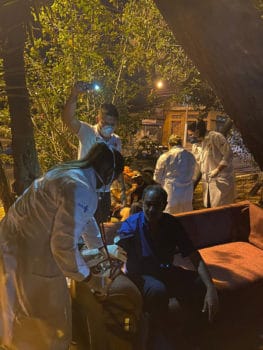
13 May 2020: Health professionals from the government programme Consultório na Rua (‘Street Clinic’) attend to unhoused patients early in the morning in São Paulo, Brazil.
PMSP/ Fotos Públicas.
Healthcare does not lend itself to the efficiencies of industrialization. Common sense indicates that patients cannot be standardized, and most of their parts are not interchangeable. Healthcare is a customized service resisting commodification and is incompatible with the efficiencies of [the] industrialized assembly line or other mass production technologies. Such basics are ignored by the high priests of market medicine. Market medicine is additionally flawed because it diverts economic resources from the community, from medical education and from research. The profits generated are not reinvested locally but are distributed to remote investors and senior management as large dividends, hefty bonuses and egregious salaries. The market has been presented as the solution, but now we know it to be the problem.
Part 2: What the Healthcare Workers Say
Tricontinental: Institute for Social Research spoke to four leaders in healthcare workers’ movements, one from each of the countries where we are based. Each of these leaders speaks at a different scale of struggle, giving us a window into the levels of the challenges that healthcare workers face.
Argentina
Understanding the situation in Argentina without considering the World Bank’s intervention in South America would be inadequate. In 1993, the World Bank focused its World Development Report on the issue of public health. While the Bank called for an increase in government spending in healthcare, it focused its attention on what it called ‘Promot[ing] diversity and competition’. By ‘diversity’ and ‘competition’, the Bank meant that the healthcare field must be diversified by increasing the for-profit sector, which would provide competition against the public sector. Rather than call for universal health coverage, the Bank encouraged the creation of private insurance schemes, the emergence of for-profit delivery of medical services, and the end to protections for domestic pharmaceutical companies.
Viviana Garcia, a leader in the healthcare workers’ union in Argentina (The Trade Union Federation of Health Professionals of the Argentine Republic or FESPROSA), told us that the impact of the World Bank policy hit most of the countries of South America very hard. She offers the examples of Chile, Colombia, Peru, and Ecuador, which saw the increase of private-public partnerships in healthcare delivery, the entry of profit-driven insurance schemes, and the overall commodification of healthcare. In these countries, the COVID-19 pandemic highlights the disaster caused by the destruction of public health systems. Ecuador’s health system has utterly collapsed, with the bodies of many of those killed by COVID-19 piling up in the streets.
In Argentina, the National Constitution of 1994 established that health is an essential public right. In 1946, the country developed a healthcare system inspired by the United Kingdom’s National Health Service. Since then, there have been several significant attempts to reform the system, particularly in the 1970s and 1980s. The health system is a mixed one, with a State sector (available to everyone), a sector for union members (Obras Sociales), and a private sector (predominantly used by the wealthy). Despite its fragmentation, the mixed system covers almost the entire population.
Pressure from the World Bank report of 1993 pushed the government to erode the public character of the state institutions in healthcare, notably with the creation of self-managed hospitals that had to rely on private financing and the privatisation of services, as well as on the creation of a precarious workforce. The new plan led to the decentralisation of healthcare to the provinces, cities, and towns, but without any proper funding mechanism; this meant that these levels of healthcare provision had to rely upon private funds, which led to inequality in the system.
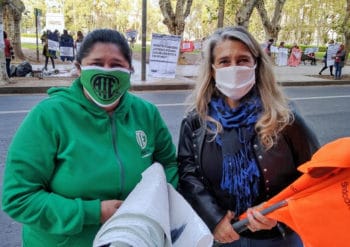
14 May 2020: FESPROSA president Fernanda Boriotti (right) at the actions organised with the Association of State Workers (Asociación Trabajadores del Estado) in Argentina. Their demands include better working conditions and wages, a sufficient supply of quality personal protection equipment, and adequate subsidies for family allowances and an emergency fund.
Sofía Alberti
The highly privatised and unequal Chilean and Colombian models could not be applied in Argentina thanks to the decisive action of organised workers. It was because of the unions and the emergence of progressive governments from 2003 to 2015 that important advances were made to defend the people’s right to healthcare and the rights of medical workers. For example, a universal child allowance was provided, health plans were developed for reproductive and sexual health, a national vaccination plan was established, job security was guaranteed for the country’s 26,000 health workers, and a path was opened for the improvement of their working conditions. Even as these were important reforms, they were insufficient to respond to the collective needs of a segmented and unequal society produced by the neoliberal policies of the 1990s.
The government of Mauricio Macri (2015-2019) swung the political pendulum to the right, pushing healthcare to an unsustainable limit. The 2016 budget for the Ministry of Health vastly underfunded the work of healthcare provision during a lethal dengue epidemic, and the Macri government cut the budget even further in 2017 and 2018. During Macri’s tenure, according to the Ministry of Finance, the government cut the healthcare budget by 22%. In 1990, the healthcare budget was around 10% of the GDP, which would fall to 9.6% in 2015, when Macri took over; by the time Macri left office, the WHO calculates, the health budget had fallen to 8% of GDP.
The Macri government cut the budgets for programmes to reduce and treat sexually-transmitted diseases (which then saw a dramatic increase in congenital syphilis and HIV-AIDS), vector-borne diseases (dengue, chikungunya, and zika), and vaccine-preventable diseases (which saw doses discontinued through a national scheme); the government also cut programmes to treat cancer. Macri went to the International Monetary Fund (IMF) for a loan, whose interest payments alone could have funded 3,200 modern hospitals. The work on four hospitals in the Buenos Aires suburbs had to be put on hold. During the Macri years, the medical system in Argentina saw an increase in informal work, the destruction of hospital services, the lack of funds for equipment, cuts in salaries, and layoffs of 1,600 workers from the country’s iconic El Hospital Nacional Posadas.
The current progressive government led by President Alberto Fernández took office in December 2019, just before the pandemic swept into South America. One of the first acts of the new government was to restore the Ministry of Health to its full stature, although it will take time for the government and the unions to recover the devastation left behind by Macri.
India
If not for the 900,000 Accredited Social Health Activist (ASHA) workers, India’s response to the coronavirus would be much less robust. These ASHA workers received no personal protective equipment (PPE) and work for a modest remuneration—which, up until recently, was as low as Rs. 1,000 to 1,500 per month (roughly U.S. $13 to 20) paid only once a year or once every two years. They go from house to house across the country to check on people, deliver medicines, check for symptoms of illnesses, and carry out basic medical care. These workers have become the most important people in India’s struggle against COVID-19. For their trouble, they have been beaten by the police and faced threats from their communities—including some of their husbands. Since government officials tell them to make their own PPE rather than make any effort to secure proper protection for them, they have had to improvise their own protection.
Studies of epidemic outbreaks show that community health workers, such as the ASHA workers, are integral to tracing the pattern of the infection and are essential for transmitting information about how to break the chain of infection. Each ASHA worker has to cover thirty households in her area in a week, constantly keeping in touch with the people to monitor the spread of the disease. Yet, in India, these workers are not even treated as workers but as ‘volunteers’ and they are routinely disrespected. On 18 April, the ASHA workers conducted a symbolic protest; they wore a black ribbon or a black scarf (chunni) to indicate their dissatisfaction with the lack of support from the government.
Surekha Rani, the General Secretary of the ASHA Workers’ Union (affiliated to the Centre of Indian Trade Unions, CITU) in the Indian state of Haryana (26 million), spoke to us about the struggles of these workers. The ASHA worker scheme was created by the National Rural Health Mission in 2005; the ASHA Workers’ Union in Haryana was formed in 2009. There are currently 20,000 ASHA workers in Haryana, 15,000 of them in the union and at least 18,000 of them active in the workers’ movement against the government. The union first emerged during the ASHA workers’ fight to be recognised as workers—rather than as volunteers—and to receive a minimum wage, social security, and other benefits. The ASHA workers perform at least forty different tasks—such as pre-natal care and immunisation for children—on behalf of the health department.
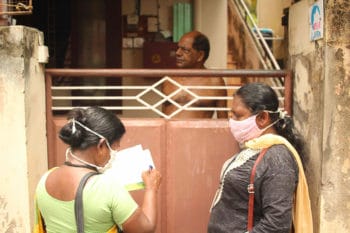
13 May 2020: ASHA workers Lathika and Usha inspect homes and surrounding premises for possible mosquito breeding sites, give instructions to residents, and track those with potential COVID-19 symptoms. Lathika is a Thiruvananthapuram District Committee member of the Kerala State ASHA Workers’ Federation (KSAWF), affiliated with the Centre of Indian Trade Unions (CITU).
Subin Dennis / Tricontinental: Institute for Social Research
In 2013, the union began an agitation to ensure that ASHA workers be paid regularly. Fourteen thousand ASHA workers took to the streets, in response to which Chief Minister of Haryana Bhupinder Singh Hooda said that one of the CITU comrades should be burnt to death. When he said that he could not agree to the union demands because he himself was going hungry, the union collected wheat flour from each of the ASHA members’ houses. ‘We made a parcel of this flour and sent it to the Chief Minister’, Surekha Rani said. ‘This embarrassed the Chief Minister, who called us to his house, apologised, and agreed to raise the incentives and the salary’. It was a start, but again, ‘it was insufficient’, Surekha Rani told us.
In 2015-16, the government said that the ASHA workers must perform their work in a digital format, but—as Surekha Rani explained—‘the government did not provide any gadgets, nor did they provide any training for how to use the software to update information’.
In 2017, an all-India agitation began, which the union in Haryana joined, holding an indefinite strike. On five occasions during this period, the union negotiated with the state government. On 2 February, the state government agreed to pay the workers a monthly salary of Rs. 4000—double the income they had been receiving—plus incentives from the central government; they also agreed to give the women workers insurance so that, upon their death, their families would receive Rs. 300,000. To facilitate their own digital information policy, the government agreed to provide an android phone to each worker. But, ‘true to its nature’, Surekha Rani said, ‘the government went back on its promises’. The workers demonstrated from March to June 2018, and since the government did not implement their promises, the workers began an indefinite strike from 7 June. The strike went on for eight days. When the union threatened to court mass arrest, the government said that it would implement the agreement, and it provided an assurance in writing. The strike ended on 15 June.
Once more, the government went back on the agreement. When the union found out that the Chief Minister of Haryana at the time, Manohar Lal Khattar, would be at a meeting in Karnal (Haryana), union members set up a tent and held an indefinite protest there. Khattar met with the union and said that their demands had been accepted, and that the finance department would soon issue a notification. ‘We told the Chief Minister that till the notification comes we will demonstrate at the district headquarters’, Surekha Rani said. This is what they have done. Men in the government would disparage them, making sexist comments about their determination to get their salaries. But the ASHA workers are not deterred. ‘We protest every two months’, Surekha Rani told us, ‘demanding the release of our salaries. We are known as a fighting [ladaku] force’.
The struggle of ASHA workers has inspired other workers in Haryana. Anganwadi (childcare) workers began their own strikes—so did the municipal workers, and so did the public transportation workers. Chief Minister Khattar accused the striking workers of being communists and thugs [badmash]. ‘We coined a slogan to counter him’, Surekha Rani said. ‘If fighting for our rights, asking for employment, asking for food, if these demands are the work of thugs, then this Red Flag of ours is famous for being carried by thugs and we will continue to be thugs’. The Chief Minister was forced to apologise.
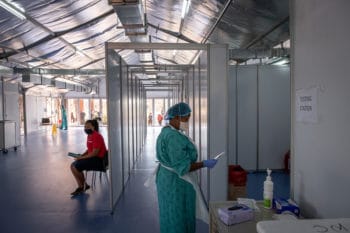
9 May 2020: Inside the testing facility at the Khayelitsha District Hospital, South Africa.
Barry Christianson / New Frame
Today, in the face of the rapidly spreading pandemic, ‘The ASHA workers are sad and demoralised’, Surekha Rani told us. ‘They are of the view that we are the ones on the ground who are working to break the chain of infection, and yet the officials are not listening to our problems’.
South Africa
On 22 April, South Africa’s president Cyril Ramaphosa announced a stimulus package of R500 billion. Stunningly, the package did not directly provide funds for healthcare providers who are at the forefront in the struggle to contain COVID-19. Lerato Madumo, the President of the Young Nurses Indaba Trade Union (YNITU), an affiliate of the South African Trade Union Federation (SAFTU), told us that this speech spurred her union to start a campaign calling for COVID nurses to stay home. The YNITU had planned a May Day strike but called it off the day before and held a press conference instead. They wrote to the president asking for urgent attention for the health providers; if their reasonable demands for compensation and safe working conditions are not addressed, this ‘will leave us with no choice but to put down our tools and stay at home’.
Sufficient testing kits and PPE are not available. Testing of providers is essential, and yet it is not happening anywhere near the scale that it is needed. ‘If one nurse contracts the virus’, Madumo says, ‘the whole shift of nurses end up being COVID-19 positive’. The medical practitioners’ union, the South African Medical Association, said that what PPE is provided is of such a poor quality that when a doctor walks, the PPE tears. In Johannesburg’s Chris Hani Baragwanath Hospital, the nurses had to come to work with raincoats that they purchased and which they had to disinfect; all this in lieu of proper PPE. The money for this improvised PPE comes from the nurses, who are paid abysmal salaries. What PPE is being provided by the government does not seem to have reached the nurses.
The president responded to the union’s demands with the statement that to strike would be a ‘criminal offence’ under the Disaster Management Act (2002). Madumo told us that the Occupation Health and Safety Act (1993) makes it clear that ‘if you believe the environment you work in is unsafe, you have the right to withdraw your labour. So, it is not even a question of whether it will be a criminal act or not; it is an issue of us saying that our government is committing a crime against humanity. Nurses are human beings. You cannot ask a soldier to fight in a war and not give them protection in the form of bulletproof vests; it is just not correct’. ‘If the frontliners continue to be sick’, Madumo said, ‘it means by the end of this COVID-19, we will have a healthcare system that does not even have healthcare providers’.
‘Even before we got into COVID-19’, Madumo told us, ‘our health system was already ailing. At the top of the list was the shortage of nurses. We went into this pandemic with a skeleton nursing staff’. In South Africa, 84% of the population is served by the public sector, and yet the private sector—which only serves 16% of the people—hires 60% of the health professionals; there is a structural understaffing of the public sector health system. The union carried out a survey which shows that there are unemployed qualified nurses. Because the government refuses to hire them, the nurses on staff are working harder than is healthy for them. ‘Nurses—besides contracting coronavirus—are getting emotionally and psychologically crushed; there is no other word to use’, said Madumo.
The level of attrition among nurses and other medical staff is extremely high, and it is often linked to widespread overwork, emotional distress, dissatisfaction, and burnout. Managers of hospitals have gained authority at the expense of clinicians and nurses; they run the hospitals like a business proposition. The hospitals have begun to rely upon nursing agencies, which traffic in the casualised employment of nurses. Madumo suggests that these agencies are dangerous because they send nurses from one hospital to another, and if these nurses contract COVID-19—and are not tested—then they can carry the disease across hospitals. ‘It becomes very difficult for infection control’, Madumo says.
Nurses have been demanding that, rather than all hospitals having COVID-19 wards, some hospitals should be designated to treat COVID-19 patients. ‘Let’s get one hospital to be the one that admits all suspected and infected cases; then the staff should come on a rotational system, a roster that will allow them to be accommodated in the nurses’ residence or doctors’ quarters of that facility’, Madumo proposes. Here the nurses and doctors should be given proper equipment and be regularly tested. Nurses and doctors have first-hand knowledge of tackling a disease, but the political class does not take their proposals seriously.
The YNITU is currently campaigning for proper personal protective equipment for all health workers, and for nurses who come into contact with a COVID-19 positive person to be tested and isolated for 14 days. Though the government is currently testing nurses who have been in contact with a case of COVID-19, it expects nurses to keep working until they receive their results—likely putting others at risk of infection.
Finally, Madumo told us that her union, YNITU, argues that this pandemic shows why healthcare should be nationalised. Each district, each province is doing what it wants, she says. ‘Nationalisation will ensure that every facility will get to be under the eagle eye of our national department of health’, Madumo said. ‘We feel that we cannot allow the private sector to do as they please as they have been doing for years. Their focus is profit-making: they insist that their nurses use one mask for five days’, she told us, even when the mask is only viable for far less time. While the masks are supposed to be disposed of after treating each patient, the nurses are also being asked to recycle them, putting themselves and their patients at an increased risk of contracting the virus.
Brazil
Brazil has among the strongest universal healthcare systems in the world, the result of social struggles led by the people. After more than twenty years under a dictatorship, the Brazilian Constitution of 1988 established the foundation for the Unified Health System (Sistema Único de Saúde or
SUS), the country’s free and comprehensive universal healthcare system. The SUS includes programmes for health surveillance, immunisation, HIV-AIDS control, care through the Family Health Programme, and a variety of other crucial medical interventions. However, the governments of the right and the neo-fascists have compromised Brazil’s laws and its universal health system. Constitutional Amendment 95 (2016)—the year of the ‘soft coup’ that unseated Dilma Rousseff (Workers’ Party) and installed right-wing Michel Temer—forced an austerity policy that freezes public spending for twenty years. This mechanism deepened the underfunding of the healthcare system, causing the system to become even more vulnerable in the face of the global pandemic.
Hugo Bethsaida Leme, a family and community physician who works in the public Basic Health Unit in Londrina (Paraná) and is a member of the National Network of Popular Doctors (Rede Nacional de Médicas e Médicos Populares), spoke to us about the impact of COVID-19 in Brazil. He told us that the SUS had been ‘historically strangled due to underfunding (approximately 4% of the GDP), a process that deepened after the coup of 2016’. The system was starved of resources. Underfunding of the system, in addition to the departure of Cuban doctors caused by Brazil’s far-right president Jair Bolsonaro, means that ‘many communities are without access to the More Doctors for Brazil Program (PMMB), which generates an overload in urgent care and emergency units with cases that could have been attended in the Basic Health Units (UBS)’.
The SUS was designed with great care and, if properly funded and managed, would be better able to deal with the global pandemic. However, the system simply has insufficient resources, and even if these are available, they are distributed unequally; most intensive care units and intensive care physicians are located in Brazil’s south and south-east.
Not only is the SUS underfunded, but the support given to the for-profit sector has undermine public health. Half of the ICU beds are in the private sector, which serves only a quarter of the population. This for-profit sector, Dr. Leme says, ‘sucks resources from the SUS and has increasingly been prioritised to the detriment of public health’. The private or for-profit sector, Dr. Leme told us, ‘has always been parasitical towards the SUS; it is only committed to its shareholders while the majority of the population continues to depend solely on the public system’. To confront such inequities and the increasing role of the for-profit sector, the Beds for All Campaign (Campanha Leitos para Todos) was started as a reaction to COVID-19; this campaign seeks to bring all hospital beds (both public and private) into one pool for this emergency, so as not to exhaust the public sector hospitals, and to divert patients to the private sector medical centres.
Nothing has made it more difficult for medical professionals than the callous anti-scientific attitude of the neo-fascists led by Brazil’s president Jair Bolsonaro. ‘The neo-fascist federal government has done a disservice by ignoring the gravity of the situation and calling on workers to die, and/or killing people with risk factors [who are forced] to go back to work in order to benefit the economic interests of the few’, said Dr. Leme.
There are not enough tests, which has obviously meant that the confirmed cases of COVID-19 are low, and which in turn has ‘generated confusion among our people regarding the disease and adhesion to the measures to break the chain’. Low levels of testing mean that the medical workers are ‘often working in the dark, without having a real dimension of the situation, including whether they are contaminated or not’, said Dr. Leme. There is just not enough PPE, not enough medical equipment, and not enough science-based action from the government.
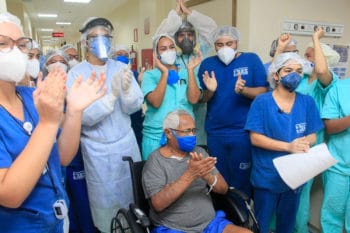
7 de maio de 2020: Equipe de médicos e enfermeiros comemoram alta de pacientes recuperados da COVID-19 no Abelardo Santos, o maior hospital público do Pará.
Marcelo Seabra/Ag.Pará/Fotos Públicas.
Dr. Leme insists that the medical question must not be reduced to the disease itself. Health, he says, must be seen in a broad, social sense. Due to the large number of unemployed and informal workers, he says, and due to the absence of labour rights and social policies, there has been an increase in hunger; hunger weakens the body and threatens illness. As a consequence of entrenched patriarchy, there have also been increased rates of violence against women during the lockdown. Those with chronic diseases—such as hypertension and diabetes—cannot see doctors during the quarantine and are therefore in danger of their health deteriorating.
For Dr. Leme, as with Dr. Teodros, health is a political issue. ‘It is urgent’, he said, ‘to fight for a sovereign, democratic, and popular government that rebuilds the SUS with adequate funds so that it can offer the necessary and adequate services to the people’—despite the messages propagated by mainstream media, ‘which demoraliz[e] the public health system and praises the private sector’. Such a government needs to improve the social conditions of its people, and to champion workers’ rights. Only then can society ‘develop in a dignified, humane, and healthy way so that if a new situation such as this arises, we can be more prepared and always put the life, rights, and welfare of our people as a priority’. The SUS, Dr. Leme, says, ‘must be a permanent part of the struggle for our people’.
Part 3: What Healthcare Workers Want
Tricontinental: Institute for Social Research studied the demands of healthcare worker unions across the world and, based on these demands, we have constructed a list. Most of the unions have very broad demands that go far beyond those of their own profession. These include broader social and economic transformation, which provides a new foundation for social life and which minimises the health hazards produced by capitalist social relations. For instance, the abolishment of the condition of homelessness (and not of homeless people, as attempted by neoliberal governments) would both help people to practice physical distancing and improve the health conditions of those who are forced—because of a lack of money—to live on the streets.
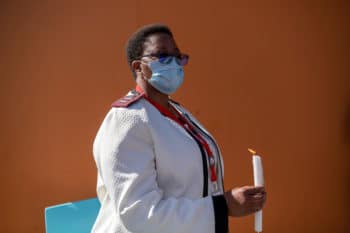
12 May 2020: Nurses from a Sebokeng clinic gather to commemorate International Nurses Day in South Africa.
Ihsaan Haffejee / New Frame
- Immediately focus the capacity of all healthcare services—both public and private—towards the treatment of serious cases of COVID-19.
- Provide special assistance to regions and communities that are severely impacted by the pandemic.
- Enforce policies such as isolation to stem the spread of the virus; institute necessary subsidies and policies to allow workers to obey the quarantine without going hungry—including informal workers—such as minimum income programs, social rent, unemployment insurance (even for non-contributors), and enable emergency access to idle properties to provide housing for those who need it.
- Protect workers by providing high quality PPE and masks, as well as other necessary equipment. Frontline workers must be adequately trained to confront the disease.
- Guarantee proper health worker identification cards for frontline health workers so that they can carry out essential health work without facing fines, violence, or other punishment issued by the State under isolation, curfew, and quarantine orders.
- Substantially increase COVID-19 testing for health workers.
- Increase equipment for hospitals and other medical centres, including ventilators and Intensive Care Unit beds.
- Acknowledge that workers have the right to withdraw their labour if they decide that to work entails an imminent risk to their health or life (this is based on the International Labour Organisation Conventions 155 and 187).
- Immediately disburse funds to set up training schools for health workers, including doctors, nurses, and public health workers.
- Increase the salaries of health workers and pay them on a frequent and regular basis.
- Guarantee the most generous health and life insurance schemes for health workers, who are the most likely to fall ill or die from the disease. All people should be guaranteed free and universal healthcare.
- Guarantee the inclusion of health workers’ unions on committees that formulate policies for the health sector in general and for the COVID-19 crisis in particular, and that they have a voice in helping to determine such policies.
- Immediately channel significant funds towards an expansion of public health programmes, including for primary healthcare, and lift austerity policies.
- Shift the entire health sector—from hospitals to rural clinics, from medical equipment manufacturers to pharmaceutical makers—into the public sector.
- Immediately turn over adequate funds for research related to this virus and to similar viruses.
- Ensure that the measures achieved in the period of the epidemic are maintained after its resolution.

